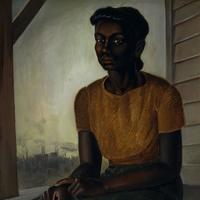More about Elsie Palmer Payne
Works by Elsie Palmer Payne

Contributor
Elsie Palmer Payne lived one of those lives that could be used to summarize all of 20th century womanhood.
She herself was a portrait, genre, and still-life artist who had some talent with color and stylization. If she had chosen to pursue her own career she likely would have achieved even more notoriety than she did, but instead, she did what many women did during the early 1900s and chose to support her artist husband whose career would, unfortunately, overshadow hers. “Come hell or high water,” she wrote to a friend, “I would never stand in the way of this very talented man’s art.” She would eventually come to regret making this choice, making her one of the many dames done wrong in art history.
It should be noted that the way that she supported her husband was not just in a monetary, or emotional sense, but often in a literal fashion as well. See, her husband Edgar was a landscape painter, and so for inspiration, they traveled constantly so that Edgar could paint on location. Moreover, he was known for painting on huge canvases, and as a result, Elsie did a lot of packing and unpacking of her husband’s massive easels, as well as caring for his oil paints, and drying paintings.
As it typically goes, Edgar took his incredibly faithful and loving wife for granted. In the end, he became domineering, and after an argument over their daughter’s marriage, they separated. For many wives of great artists, this would be the end of Elsie’s art story, however, such was not the case. In the 1920s Elsie had begun to exhibit her own work, after leaving her husband she was able to double down on her art and used her medium as a way to heal. With the help of a psychologist, she was able to order her damaged inner life, and where other artists were crumbling under the weight of the Great Depression, she was able to open a school. She would then find further success painting portraits of people of color and those who lived on the fringes of 20th century American life, many of whom were looked down on by Abstract Expressionists, a style that was popular at the time.
Her work, while not entirely unacknowledged, wouldn’t really gain the attention it deserved until the ’60s and '70s when she found an audience in parts of California. Better still, where her husband’s work gradually fell away from the public eye, Elsie’s work has only acquired more and more notoriety with the new demand for more stories involving people of color. Her work currently enjoys a home at the Oakland Museum of California Art. While she is not around to receive this credit, such is normally the case when it comes to truly great artists, it is comforting to know that she might ultimately get what she earned long ago.
Sources
- Seed, John “Delving Into the Story of a Black Woman Waiting for a Bus in Postwar Los Angeles” Hyperalergic 04/12/19 https://hyperallergic.com/494470/elsie-palmer-payne-bus-stop-1949/
- Web Contributor “Elsie Palmer Payne” Laguna Art Museum viewed on 03/18/2020 https://lagunaartmuseum.org/artist/elsie-palmer-payne/
- Web Contributor “Elsie Palmer Payne” Blue Heron Gallery viewed on 03/18/2020 http://www.blueherongallery.net/elsie-palmer-payne/

Contributor
Elsie Palmer Payne is her name, painting California is her game
Elsie Palmer Payne, though she was born in Texas in 1884, grew up in Los Angeles and San Francisco - a California Gurl (à la Katy Perry) through and through. When researching Elsie, it’s hard not to find her work intertwined with or overshadowed by that of her husband, Edgar Alwyn Payne (an American Impressionist). Elsie voluntarily supported her husband’s artistic career more than she advocated for her own. It’s time we gave her her due!
Elsie knew she wanted to pursue art when she was in high school in San Francisco. Similar to Andy Warhol, she worked at an advertising company early in her career. Simultaneously, she received classical training at Best Art School. When I imagine art school types, I picture piercings, self-cut bangs, and existential dread. I think Elsie Palmer was probably a little more refined, considering her father came from an aristocratic English family.
Elsie met her future husband, Edgar, in 1909, when he traveled from Chicago to San Francisco on a sketching trip. You can imagine what followed…she probably wanted Edgar to paint her like one of his California girls… are you sick of that joke, yet? I could go on for days. Anyway, what actually followed was a long and successful artistic career for the both of them.
Throughout their marriage, they lived in Chicago, Laguna Beach, New York, and Los Angeles, and they traveled extensively through Europe. One of Elsie’s best known later watercolors, A Decent Burial, was probably inspired by a scene she witnessed in Italy. However, Laguna Beach and Los Angeles were the two locales that would most influence her style. Elsie and Edgar co-founded the Laguna Beach Art Association in 1918, through which they would exhibit their paintings and drawings continuously.
Edgar and Elsie separated in 1932, and Elsie supported herself by teaching art classes. You go, girl! During the separation, Elsie pursued more oil painting, as opposed to quicker media like gouache or watercolor. She painted views of Los Angeles, her hangouts (Thrifty Drug Store, 1945), and locals of LA. For many of her portraits, Elsie used black models (including Bus Stop, A Colored Gentleman, and Blues in the Night).
After Edgar’s death, Elsie acquired a new studio from which she painted views of Los Angeles. Most of her energy, however, was spent exhibiting and lecturing on Edgar’s work until she died in 1971. She was definitely a devoted wife to the end.
Sources
- Coen, Rean Neumann. The Paynes, Edgar & Elsie: American Artists. Minneapolis: Payne Studios, Inc., 1988.
- Sonstegard, Viki. “Elsie Palmer Payne: Illustrator and Painter.” Women Out West: Art on the Left Coast. Last modified March 5, 2013. Accessed July 25, 2019. http://womenoutwest.blogspot.com/2013/03/elsie-palmer-payne-illustrator….
- Stern, Jean. “Elsie Palmer Payne (1884-1971).” In Elsie Palmer Payne, by Jean Stern and Evelyn Payne Hatcher. Los Angeles: Petersen Publishing Company, 1990.
Featured Content
Here is what Wikipedia says about Elsie Palmer Payne
Elsie Palmer Payne (1884 – 1971) was an American painter known for her landscape and genre painting.
Payne was born in San Antonio, Texas on September 9, 1884. She attended Best Art School in San Francisco. In 1912 she married fellow artist Edgar Alwin Payne, with whom she had one child, Evelyn, born in 1914. The couple resided in Chicago for several years and, at that time, Payne assisted her husband in creating several murals. The couple relocated to California in 1918. They both were founding members of the Laguna Beach Art Association.

The family led a peripatetic life, visiting Europe several times and living for a time in New York. The couple separated in 1932. Payne settled in Los Angeles. There she taught art and continued her painting. Payne exhibited regularly, including at the Palette and Chisel Club, the Laguna Beach Art Association, the Los Angeles County Museum of Art, and the Pasadena Art Institute.
She reunited with her husband in 1946 and she took care of him until his death from cancer in 1947.
Payne died in Minneapolis, Minnesota on June 17, 1971.
Her work is in the Laguna Art Museum and the Minneapolis Institute of Art.
In 1988 the Carnegie Art Museum held a retrospective of her work entitled Elsie Palmer Payne; Out of the Shadow.
Check out the full Wikipedia article about Elsie Palmer Payne











